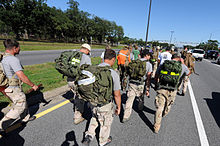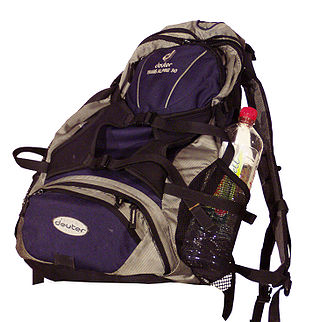
A backpack—also called knapsack, rucksack, pack, booksack, bookbag, haversack or backsack—is, in its simplest frameless form, a fabric sack carried on one's back and secured with two straps that go over the shoulders; but it can have an external or internal frame, and there are bodypacks.

The Canon d'Infanterie de 37 modèle 1916 TRP was a French infantry support gun, first used during World War I. TRP stands for tir rapide, Puteaux. The tactical purpose of this gun was the destruction of machine gun nests.

The M-28 or M-29 Davy Crockett Weapon System was a tactical nuclear recoilless smoothbore gun for firing the M388 nuclear projectile, armed with the W54 nuclear warhead, that was deployed by the United States during the Cold War. It was the first project assigned to the United States Army Weapon Command in Rock Island, Illinois. It remains one of the smallest nuclear weapon systems ever built, with a yield of 20 tonnes of TNT (84 GJ). It is named after American folk hero, soldier, and congressman Davy Crockett.
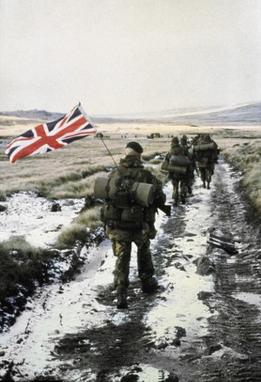
Yomp is Royal Marines slang describing a long-distance loaded march carrying full kit. It was popularised by journalistic coverage in 1982 during the Falklands War. The origin of the word is unclear, and there is no evidence to suggest that it derives originally from an acronym. Various backronymic definitions have however been proposed, including "young officers marching pace", "your own marching pace" and a connection with the term yump used in rally-driving in the sense of "to leave the ground when taking a crest at speed", apparently a Scandinavian pronunciation of jump.

The M224 60 mm Lightweight Company Mortar System (LWCMS) is a smooth bore, muzzle-loading, high-angle-of-fire mortar used for close-in support of ground troops. It was deployed extensively in the War in Afghanistan by the United States military.
The Expert Infantryman Badge (EIB) is a special skills badge of the United States Army.
A combat shotgun is a shotgun issued by militaries for warfare. The earliest shotguns specifically designed for combat were the trench guns or trench shotguns issued in World War I. While limited in range, the multiple projectiles typically used in a shotgun shell provide increased hit probability unmatched by other small arms.

A pack animal, also known as a sumpter animal or beast of burden, is an individual or type of working animal used by humans as means of transporting materials by attaching them so their weight bears on the animal's back, in contrast to draft animals which pull loads but do not carry them.
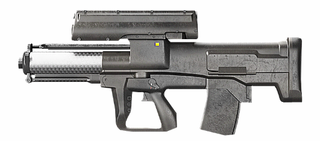
The XM25 Counter Defilade Target Engagement (CDTE) System, also known as the Punisher and Individual Semiautomatic Air Burst System was an airburst grenade launcher with programmable ammunition derived from the XM29 OICW. It was fielded to soldiers serving in the War in Afghanistan in 2010, after which malfunctions and 2013 program budget cuts delayed official entry into service, planned for early 2017. In early 2017, the contract with Orbital ATK was cancelled, calling the future of the entire program into question. The program was officially terminated on 24 July 2018.
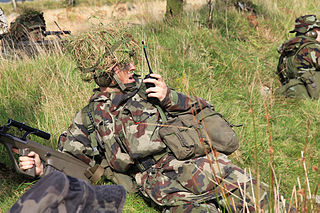
Personal Load Carrying Equipment (PLCE) is one of several tactical webbing systems of the British Armed Forces. Dependent upon the year of design, and the decade of introduction, the webbing system was named and is commonly referred to as the 85 Pattern, the 90 Pattern or the 95 Pattern webbing.

M320 Grenade Launcher Module (GLM) is the U.S. military's designation for a new single-shot 40 mm grenade launcher system to replace the M203 for the U.S. Army, while other services initially kept using the older M203. The M320 uses the same High-Low Propulsion System as the M203.
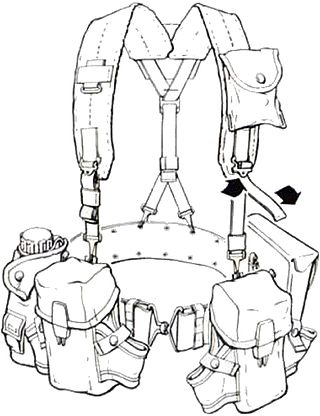
The All-Purpose Lightweight Individual Carrying Equipment (ALICE) is a set of load-carrying equipment adopted as United States Army Standard A on 17 January 1973 to replace the M-1956 Individual Load-Carrying Equipment (ILCE) and M-1967 Modernized Load-Carrying Equipment (MLCE). Although since superseded by MOLLE, ALICE gear is still in some limited use with the U.S. Army National Guard, State Guard, also some ground units of the Navy and Air Force.

The All Arms Commando Course (AACC) lasts for 13 weeks and is run by the Royal Marines at the Commando Training Centre Royal Marines (CTCRM), Lympstone. Members from any of the United Kingdom's Regular Armed Forces and overseas exchange personnel can attend to serve with 3 Commando Brigade. On completion of the course the successful candidate earns the right to wear the green beret, and to wear the "Commando Dagger" on their uniform. The Royal Marines expect that nearly half of the volunteers will drop out or be dismissed before completing the AACC. The primary aim of the course is to give service personnel the core military skills necessary for Extremely and Very High readiness Commando and Littoral Strike operations.
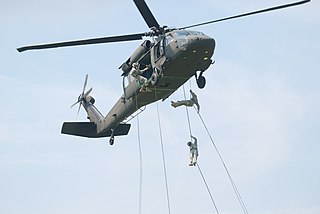
The United States Army Air Assault School, is an Army Forces Command Table of Distribution and Allowances unit located at Fort Campbell, Kentucky. Its primary task is training leaders and soldiers assigned to the 101st Airborne Division (AASLT), other United States Army units, and United States Armed Forces service members. The school is named for Command Sergeant Major Walter James Sabalauski.
Squad Mission Support System is an unmanned all terrain wheeled vehicle developed by Lockheed Martin.

Pegasus Company is a training and selection organisation of the British Armed Forces based at the Infantry Training Centre, Catterick, North Yorkshire. P Coy run the 'Pre-Parachute Selection' courses for Parachute Regiment recruits and regular and reserve personnel from across the UK armed forces who volunteer to serve in a parachute role within 16 Air Assault Brigade.
In the British Army, the Annual Fitness Test is designed to assess soldiers' lower and upper body strength and endurance. The test was formerly known as the Combat Fitness Test – and is still colloquially known by soldiers as the CFT. The test involves a fast-paced march at fifteen minutes per mile, in full combat gear including the SA80 personal weapon, across rough terrain and on roads. The exact weight of the equipment carried depends upon the type of unit and it is usually 15 kg to 25 kg dependent on service or arm, but all will cover a distance of 8 miles in less than 2 hours.
The 60mm HVMS gun is a self-loading autocannon jointly developed by OTO Melara of Italy and the Israel Military Industries (IMI). It was designed to be mounted on light armoured vehicles to provide an anti-armour capability using high-velocity sub-calibre kinetic ammunition.

The XM7, previously known as the XM5, is the U.S. Army variant of the SIG MCX Spear, a 6.8×51mm, gas-operated, magazine-fed, assault rifle designed by SIG Sauer for the Next Generation Squad Weapon Program in 2022 to replace the M4 carbine. The XM7 features a free-floating reinforced M-LOK handguard for direct accessory attachment to slotted hole mounting points.
